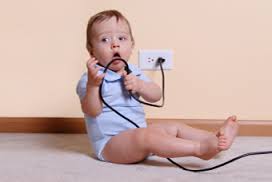Electrical safety in
the Home Electricity is now the major cause
of accidental fires in homes. UK Government statistics show that electricity
causes almost half of all accidental UK house fires. U.S. fire departments
responded to an estimated annual average of 47,820 reported home fires
involving electrical failure or malfunction in 2007-2011. Each year,
many people are killed and thousands are seriously injured due to an electrical
accident in the home.
Modern living virtually depends on electricity in the
home. We now have electrical appliances for virtually every home chores and comfort.
The risk of electrical accidents in the
home has increased proportionately.
It is important that any electrical installation work in your house is
carried out only by people who are competent. This means people who have the
knowledge, skills and experience needed to avoid dangers to themselves and
others.. It's easy to make an electrical circuit work - it's far harder to make
the circuit work safely.
Faulty and aging wiring is one of the major causes of electrical fires in
the home. You can avoid these by having regular checks carried out on the
condition of your cables, switches, sockets and other accessories. There are
clear signs that can help you tell the age of electrical installations in your
home. These are:
·
Cables coated in black rubber (phased
out in the 1960s);
·
Cables coated in lead or fabric
(before the 1960s);
·
A fuse-box with a wooden back, cast
iron switches, or a haphazard mixture of fuse boxes (before the 1960s);
·
Older round pin sockets and round
light switches, braided flex hanging from ceiling roses, brown and black
switches and sockets mounted in skirting boards (before the 1960s); and
Wall-mounted light switches in bathrooms (before the 1960s)
Electrical dangers around the home
·
Never ignore warning signs like
burning smells, sounds of arcing (buzzing or crackling), fuses blowing or
circuit-breakers tripping.
·
Replace or repair damaged or loose
electrical cords.
·
Avoid running extension cords across doorways or under carpets.
·
In homes with small children, make sure your home has
tamper-resistant (TR) receptacles.
·
Avoid overloading outlets. Plug only one high-wattage appliance
into each receptacle outlet at a time
·
Consider having additional circuits or outlets added by a
qualified electrician so you do not have to use extension cords.
·
Make
sure all electric cords are tucked away, neat and tidy. Pets
might chew on electrical cords, and people might trip and fall.
|
·
If outlets or switches feel warm,
frequent problems with blowing fuses or tripping circuits, or flickering or
dimming lights, call a qualified electrician.
|
·
DON'T
yank an electrical cord from the wall. Pulling on a cord can
damage the appliance, the plug or the outlet.
|
·
Always
look up and look out for power lines before you climb a tree. The
electricity can go right through the tree branch - and right through you!
·
Put
safety caps on all unused electrical outlets. Covering outlets will
also help save energy by stopping cold drafts.
·
Follow the manufacturer's
instructions for plugging an appliance into a receptacle outlet.
·
Place lamps on level surfaces, away
from things that can burn and use bulbs that match the lamp's recommended
wattage.
·
Make sure your home has ground fault
circuit interrupters (GFCIs) in the kitchen bathroom(s), laundry, basement,
and outdoor areas.
·
Arc-fault circuit interrupters
(AFCIs) should be installed in your home to protect the electrical system.
|




No comments:
Post a Comment